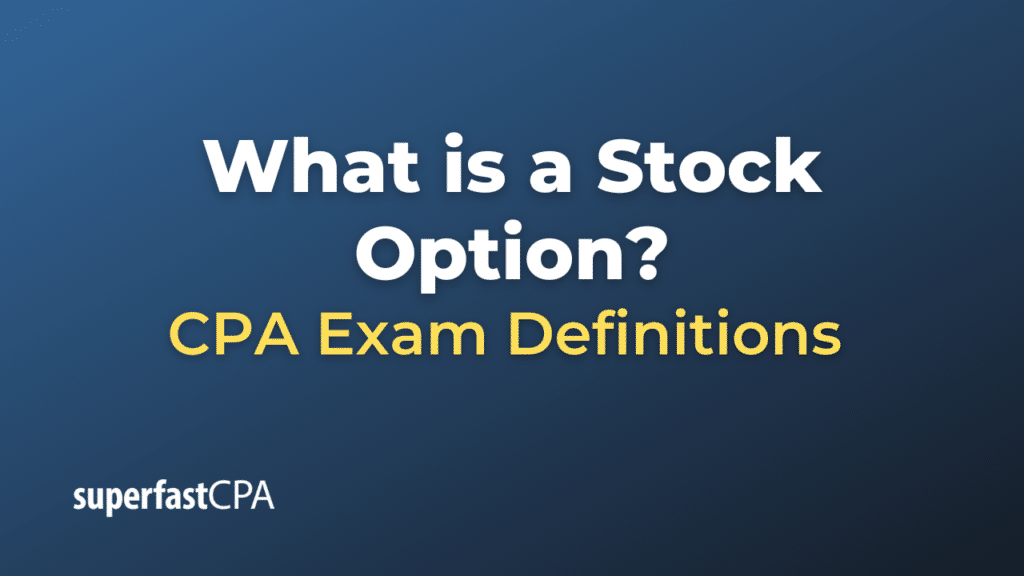Stock Option
A stock option is a financial instrument that gives the holder the right, but not the obligation, to buy or sell shares of a company at a predetermined price, known as the “strike price,” within a specified period of time. Stock options are a common form of compensation provided to employees, particularly in startups and larger corporations, as a way to incentivize performance, align employee and shareholder interests, and attract and retain talent.
There are two primary types of stock options:
- Call Options: These give the holder the right to buy shares at the strike price. If the market price of the stock rises above the strike price, the holder can exercise the option to buy the stock at the lower strike price and then sell it at the current market price for a profit.
- Put Options: These give the holder the right to sell shares at the strike price. They become more valuable as the price of the stock falls, since the holder can sell shares at a price higher than the current market rate.
When discussing stock options in the context of employee compensation, there are also two primary types:
- Incentive Stock Options (ISOs): ISOs are typically offered to employees and come with tax benefits. If certain conditions are met, the gains from exercising these options can be taxed at a long-term capital gains rate, which is usually lower than the ordinary income tax rate.
- Non-Qualified Stock Options (NSOs or NQSOs): NSOs do not come with the special tax benefits that ISOs have. The difference between the stock’s current market value and the option’s strike price is taxed as ordinary income when the option is exercised.
Example of a Stock Option
Let’s illustrate the concept of stock options with a detailed example.
Example: Sarah’s Stock Options at Startup XYZ
Sarah is a software engineer who joins a startup named XYZ. As part of her compensation package, she’s granted 5,000 stock options with a strike price of $20. These options vest over four years, meaning she gains the right to exercise (buy) 1,250 shares each year at the predetermined price of $20 per share.
Scenario 1: Successful Growth
Four years later, thanks to the team’s hard work and some successful products, the market price of XYZ’s stock has surged to $100. Sarah’s options have fully vested.
Now, Sarah can exercise all her options:
- She can buy 5,000 shares at the strike price of $20, costing her $100,000.
- She can immediately sell these shares at the current market price of $100 each, netting her $500,000.
Sarah’s gross profit would be: $500,000 (from selling) – $100,000 (cost of buying) = $400,000.
Scenario 2: Market Downturn
Unfortunately, not all startups succeed. Let’s say that after four years, due to market challenges and stiff competition, XYZ’s stock is only valued at $10.
In this case:
- Sarah’s stock options have a strike price of $20, which is higher than the current market value of $10.
- It would make no financial sense for Sarah to exercise her options, as she’d be buying the stock for more ($20) than what it’s currently worth ($10). She would let the options expire without exercising them.
Scenario 3: Job Change and Early Exercise
Two years after joining XYZ, Sarah decides to leave for another opportunity. By this point, half of her options have vested, allowing her to buy 2,500 shares at $20 each.
If XYZ’s stock price is at $30 when she leaves:
- Sarah can exercise her vested options and buy 2,500 shares at $20 each, costing her $50,000.
- She can then sell them for $30 each, gaining $75,000.
Her gross profit would be: $75,000 (from selling) – $50,000 (cost of buying) = $25,000.
However, many companies have a policy where employees must exercise their vested options within a certain period (e.g., 90 days) after leaving. If Sarah doesn’t exercise within that timeframe, she might lose her vested options.
These scenarios provide insights into how stock options can be a lucrative part of an employee’s compensation package but also come with their own risks and considerations.













